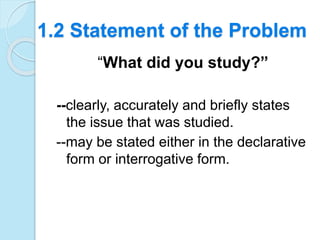Chapter 1 Research
- 1. CHAPTER 1: THE PROBLEM AND ITS BACKGROUND Part1 of a scientific paper
- 2. 1.1 Background of the Study “Why did you conduct the study?” --describes the circumstances that suggested in the research.
- 3. Kalanchoe pinnata (Kataka-taka) have the ability to synthesize a wide variety of chemical compound that are used to perform important biological functions and to defend against attack from predators such as insects, fungi and herbivorous mammals. Many of these consumed by humans and can be used to effectively treat the human diseases. Medicinal plants have been identified in used through out human history. It finds application in pharmaceutical cosmetic, agricultural and food history. The use of medicinal herbs for curing disease has been documented in history of all civilizations. The use of herbs to treat disease is almost universal among non-industrialized societies, and is often more affordable than purchasing expensive modern pharmaceuticals. According to the World Health Organization (WHO)estimates that 80 percent of the population of some Asia and African countries presently use herbal medicine for some aspect of primary health care. Studies in the United States and Europe have shown that their use is less common in clinical settings, but has become increasingly more in recent years as scientific evidence about the effectiveness of herbal medicine has become more widely available. Kalanchoe pinnata was chosen to be studied because it comes in abundant source and is available. In this study, isolated compounds from Kalanchoe pinnata underwent partial characterization and were tested for antibacterial property against Escherichia
- 4. 1.2 Statement of the Problem “What did you study?” --clearly, accurately and briefly states the issue that was studied. --may be stated either in the declarative form or interrogative form.
- 5. The main problem of the study is to utilize fish offal from boneless fish (C. chanos) into burger. Specifically, it attempts to answer the following research questions. 1. What is…………………………………………….? 2. What is …………………………………………….? 3. How do……………………………………………?
- 6. 1.3 Hypotheses Proposed solution Tentative explanation Educated Prediction Meant to be tested --should be clear & brief. --should be based on past experiences or observations or on information gathered from your research. --must be testable.
- 7. Types of Hypotheses 1. RESEARCH HYPOTHESIS alternative hypothesis stated in a declarative form. Examples: a. Insect a develops resistance to Pesticide X. b. If the concentration of Substance A is increased, then plant growth will be reduced. 2. STATISTICAL HYPOTHESIS Null hypothesis Refers to populations and represents the vehicle by which findings are generalized from the sample to the population. a. When a sample of Insect A is regularly exposed to Pesticide X for one week, 100% of the sample will die; None will survive. b. The mean heights of plants exposed to 0%, 10%, 20% and 30% Substance A are not significantly different.
- 8. 1.4 Conceptual Framework Is a general statement which forms the frame of reference for your inquiry or investigation. Sets out the rationale which underlies --Why you do/What you do? --How you do your research? 2 TYPES OF DIAGRAMS REPRESENTING OF: 1. Relationships of the KEY CONCEPTS involved in the study. 2. Relationships of the KEY VARIABLES to be investigated.
- 9. KEY VARIABLES The effect of Aloe vera extract on the rate of growth and regeneration of Planaria Effectiveness of culturing grouper in fish cages using bread meal as supplemental feed Aloe vera Regeneration of Planaria Growth of Planaria Supplemental feed (Bread Meal) Salinity Temperature Oxygen pH Growth Rate
- 10. KEY CONCEPTS
- 11. 1.5 Significance of the Study The relevance of the research to felt needs. How the research output may be directly useful to people? The explanation of it is presented either 1. INDUCTIVE PERSPECTIVE – particular to general 2. DEDUCTIVE PERSPECTIVE – general to particular
- 12. Realizing the acute environmental hazards and problems associated with the accumulation of mine tailings in mining companies which one of our country’s, and also of the world’s major industries, this research intends to utilize these mine tailings, instead, as alternative raw material for earthenware. Recycle and compost, there is cash in trash is the Earthenware's’ 4th commandment. (Philippine Star, April 4, 1999). These earthenwares have potential commercial values: earthenware vases as an export winner and ceramic tiles for low cost housing project.
- 13. 1.6 Scope and Delimitation of the Study Coverage of the study: Area Subject/problem Research apparatus, equipment or instrument Time frame Any limitations in the reference population, sample size
- 14. The leaves of Kalanchoe pinnata were percolated in 150c milliliters of ethanol for two weeks. The crude extract was subjected to phytochemical screening test: test for alkaloids and tannins. The Gas Chromatography-Mass Spectra analysis was done for the instrumentation at the Coca Cola Plant, Sta. Rosa Laguna. The Microbial analysis with Escherichia coli, Staphylococcus aureus and Candida albicans were done at the Microbiological Research and Services of the Natural Sciences Research Institute.
- 15. 1.7 Definition of Terms Includes terms which should be interpreted in a manner unique to your research. Includes all the important variables in the study. The definitions may be: 1. CONCEPTUAL – based on concepts or hypothetic ones which are usually taken from dictionary, encyclopedia & published journals. 2. OPERATIONAL – based on observable characteristics & how it is used in the
- 16. PAPER WORKS Based on your research title chosen, formulate the ff.: Background of the Study Statement of the Problem Hypothesis Conceptual Framework Significance of the Study Scope & Delimitation Definition of Terms
- 17. REMINDERS: Pass your NOTEBOOK and CLEAR BOOK on Nov. 2 or 3, 2016. LONG TEST on Nov. 10, 2016. Pass your Chapter 1(Draft) on November 2-4, 2016. Presentation of Chapter 1 on November 11, 2016. Study well and ENJOY your SEMBREAK. God bless!

















